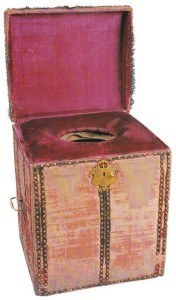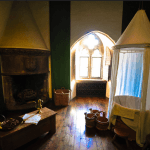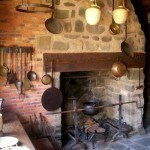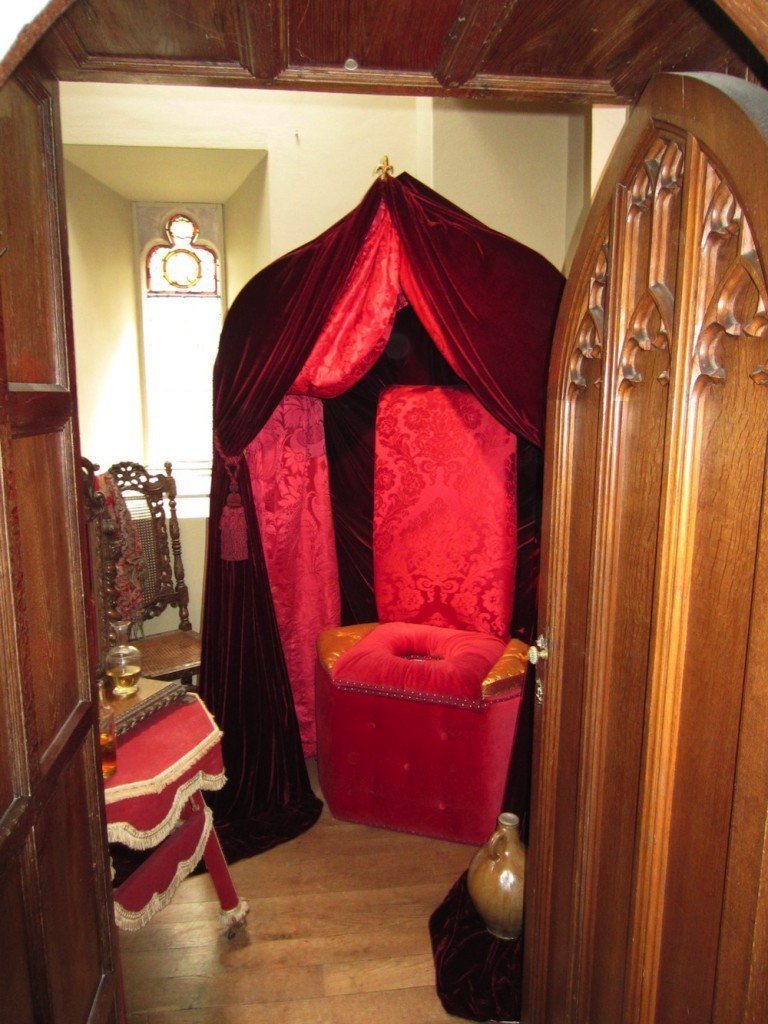
Henry VIII Royal Closed Stool in his bedchamber at Sudeley Castle in the Cotswolds, the home of Katherine Parr, his sixth (and final) wife.
Tudor Dollhouse Toilets
When thinking about Tudor dollhouse toilets, remember that almost all hygienic functions in the Tudor era took place in the bedchamber or an adjacent alcove. Castle dwellers and the merchant class had choices. They could have a garderobe, for instance. a sort of privy that hung on the outside of the building. Or they could use closed stools and chamber pots. But for most of the population, human waste was disposed of in the most convenient places: out back in the garden or out front in the street. Dollhouse enthusiasts need not be too graphic about the subject. We have choices too.
The Garderobe
Tudor castles and manor houses often utilized the garderobe, a small room jutting out of an exterior wall, well above ground level. Usually windowless, it had a hole in the floor with a seat of wood or stone built over it. A chute would care the deposits to a moat, river or cesspit – sometimes to the middle of a street.
According to historian Dan Snow, “the name garderobe – which translates to guarding one’s robes – is thought to come from the practice of hanging heavy clothing in the toilet shaft because the ammonia from the urine would kill fleas.” Now that’s some dual-purpose room.
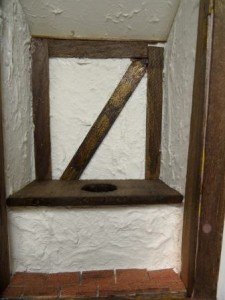
A miniature garderobe created by Pat Davies of Lili-Anne Miniatures. Instructions to make one are in Dolls House and Miniature Scene, Issue 128
And for clean-up? The toilet paper roll wouldn’t be invented until the mid-Victorian era, around 1860. The wealthy might use soft lamb’s hair or something similar. Next best was “printed matter:” old newspapers, magazine, etc.
Closed Stools
This is a chair with a hole cut in the center of the seat. A basin would slide in and out underneath, to be emptied every morning by the Groom-of-the-Stool, the most honored of the King’s personal servants. It looks like baby’s first potty, but my kids didn’t have a padded seat covered with plush fabric. This would serve well as a Tudor dollhouse toilet.
Not that privacy was a big thing in Tudor times. Henry VIII’s closed stool in his bedchamber at Sudeley Castle, pictured above, was so elaborate because he thought it fitting to receive courtiers begging for favors during his morning “time for the necessaries.”
Chamber Pots
They were kept under the bed or in a bedside table, with or without a door. Some had lids; many didn’t. If there was no nearby stream or river, a chambermaid would empty the pot on a cesspit outside the back door, to be shoveled out and carted away by another servant.
Privacy? What Privacy?
The dining rooms of the better homes usually had a low cupboard in the corner, or in the hall, where a ‘potty’ was kept. If any guest felt the ‘need’ this potty would be used in full view of the other diners. Privacy was not only of little concern to the Tudors, Dougless Bitler tells us in one of her excellent books, “Ask Dougless,“ about a public privy in Colonial times (a ten-holer, I think) where the town fathers gathered every morning to discuss weighty matters of the day. If one of the worthies performed particularly well with his “morning necessaries,” he got a resounding round of applause.
I used the word privy quite a bit in this article about Tudor toilets, which is one meaning of the word. Another use of the word “privy” relates to “private” or “secret” and usually refers to an advisory group to a monarch or other leader.
The Lower Classes
Humble individuals in Tudor times had no choice but to dispose of the waste anywhere they could. During the summer, it could be an area outside of the dwelling; some sort of potty or chamber pot would be used during the winter months when the waste would be disposed of quite close to the dwelling – into the street. Sometimes there would be an open gully running down the center of the street where the waste would flow and collect in a more convenient spot for collection. For the less conscientious the contents would be disposed of from the nearest window. It was a good idea for pedestrians to keep an eye on the sky when the street got narrow.
The poor would clean-up with whatever was available, more often than not, a handful of moss.
A Tudor Aristocrat Invented The First Toilet
In 1596, the first flush toilet was invented by Sir John Harrington. He made one for himself and one for his godmother, Queen Elizabeth I. These were the only two ever produced. After Sir John published a book describing his invention, he was mocked into retirement for his foolish creation.
It took almost 200 years before anyone else attempted to create a flushing toilet. In 1775 and 1777, Alexander Cummings and Samuel Prosser each made strides in the reemergence of the water closet. Then in 1885, Thomas Twyford created the first valve-less toilet made of china. It is widely reported that Thomas Crapper invented the toilet. Not true. He did own a plumbing supply store in London and bought the rights to a patent for a “Silent Valveless Water Waste Preventer,” the modern “S” trap, but he should not be credited with inventing the toilet.
Sorry about using some real-life photos, but if your Tudor project includes dealing with “the necessaries,” you may be looking at a DIY project. There are not a lot 1:12 scale Tudor toilets on the market.
Susan Downing, with Patrick Owens



